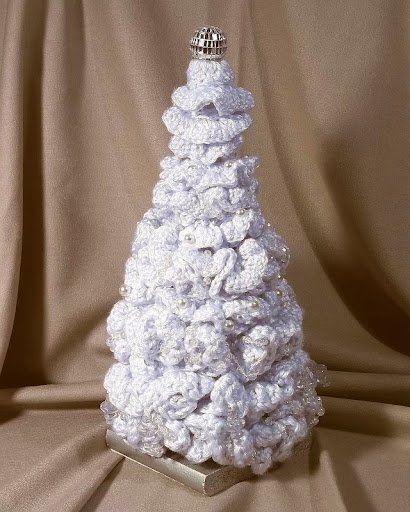 |
| Colorado Avalanche fan with her tree |
There are some craft items I never tire of making, even after several decades of making them. One of these is the tabletop tree. It all began many years ago with two patterns in a McCall's magazine. One pattern was for a little Christmas tree to be made with cotton crochet thread. It was to be crocheted in the round, then partially flattened to be made into a lapel ornament. The second pattern was for a Christmas wreath lapel pin. Considering my preference for yarn over thread, I couldn't help wondering what would happen if I substituted knitting worsted for the thread and the larger aluminum hooks for the smaller steel ones. I couldn't wait to find out, so I collected green yarn and crochet hooks in sizes G through K. I began to experiment and soon had a neat little layered tree shape about 10 inches tall and a wreath between 10 and 12 inches in diameter.
The original tree and wreath were supposed to be starched to make them hold their shape and then be laced onto pin backs from a craft store. That obviously would not work for my yarn creations.
My husband volunteered to make a “tree trunk” from a block of wood and a dowel and to bend a wire coat hanger into a circle as a frame for the wreath. He made these items and painted the tree trunk brown. I laced the wreath onto the wire circle and decorated it with small ornaments and a bow. I glued felt to the bottom of the tree base so it couldn't scratch furniture and arranged the crocheted layers an the trunk, decorating them with miniature ornaments. We were both pleased with the results and immediately set to work to produce a tree and a wreath to add to each of his sisters' Christmas boxes.
 |
| "Heartwood", a Valentine's Day-themed tree |
My best friend was teaching second grade in another state. When she received her Christmas tree, she called me to ask if I could make trees for other holidays that she could display in her classroom. I began collecting tiny items with holiday themes. Eventually I made her trees for Valentine's Day, St. Patrick's Day, Memorial Day, Back-to-School Night, Halloween, and Thanks-giving. I began to make themed trees for relatives, friends, and co-workers. Our children, niece, and nephews graduated from high school and went off to college, military service, marriage and jobs away from home. Each of them needed a “starter” tree for their new beginnings. I made more than a hundred trees in this way and am proud to say no two were ever alike. Trees for the men were always fun. I trimmed them with everything from fishing lures to tiny model cars to dice and poker chips.
 |
| One of several trees made for Broncos fans |
Along the way I acquired a son-in-law who is a devoted Denver Broncos' fan and a grand-daughter who is equally loyal to the Colorado Avalanche. Of course they had to have trees in their team colors to decorate with memorabilia. I'm a die-hard Bronco fan myself, so it is a little bit embarrassing to admit that my favorite among the team trees I have made was one that I made recently as a special order for an Oakland Raiders' fan. I did it in black, white, shades of gray and metallic silver and it looked elegant. I'd like to do a Seattle Seahawks' tree because I love their colors.
 |
| Undecorated tree with an alternative shape |
 |
| Moonlight on Snow, appropriate for a bridal shower |
 | |
| The Patriot, available in our Etsy shop |
I hope you've enjoyed this little stroll through my “forest”. Best wishes,
Annake
This post by Annake's Garden is licensed under a Creative Commons Attribution-NonCommercial-ShareAlike 3.0 Unported License.








